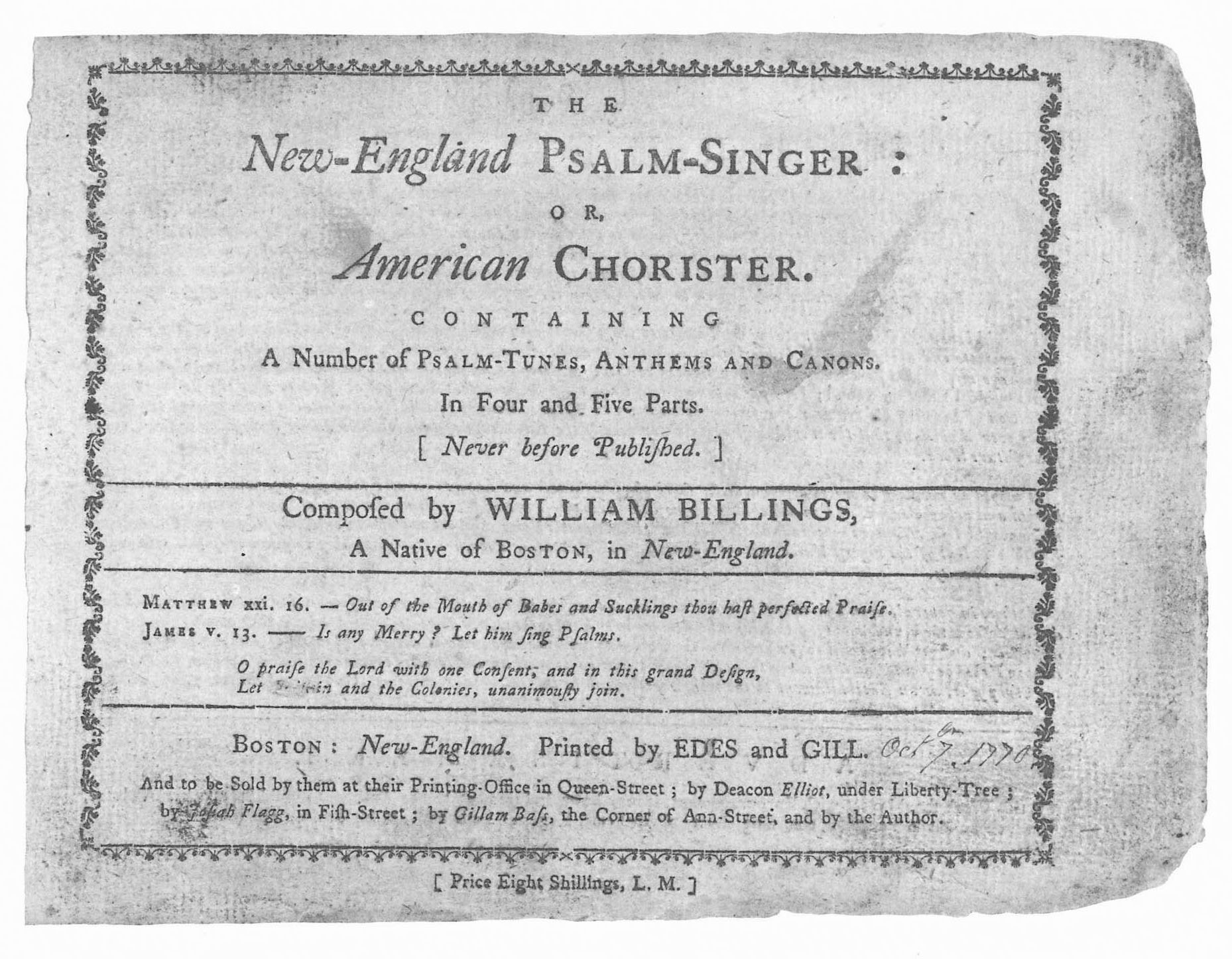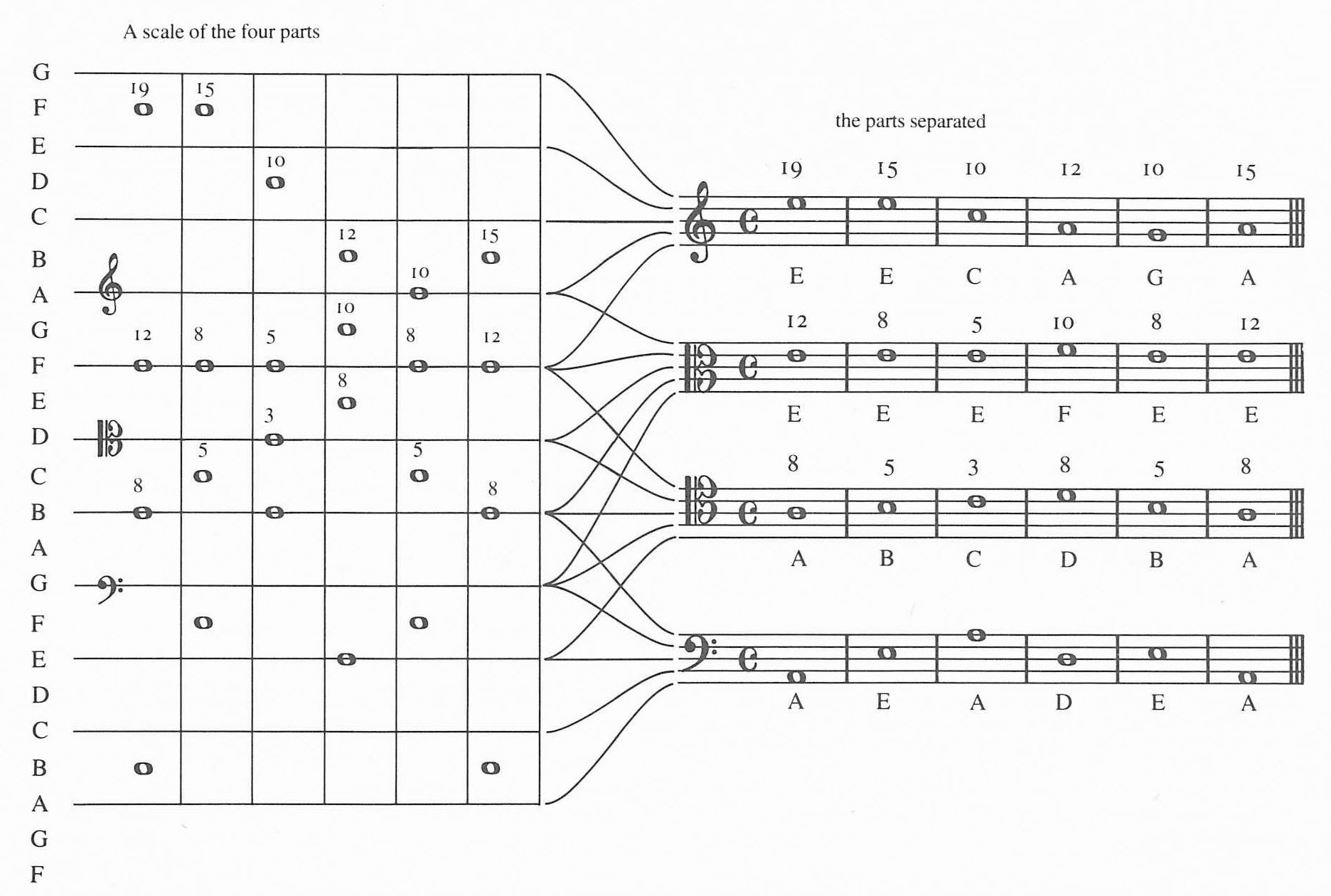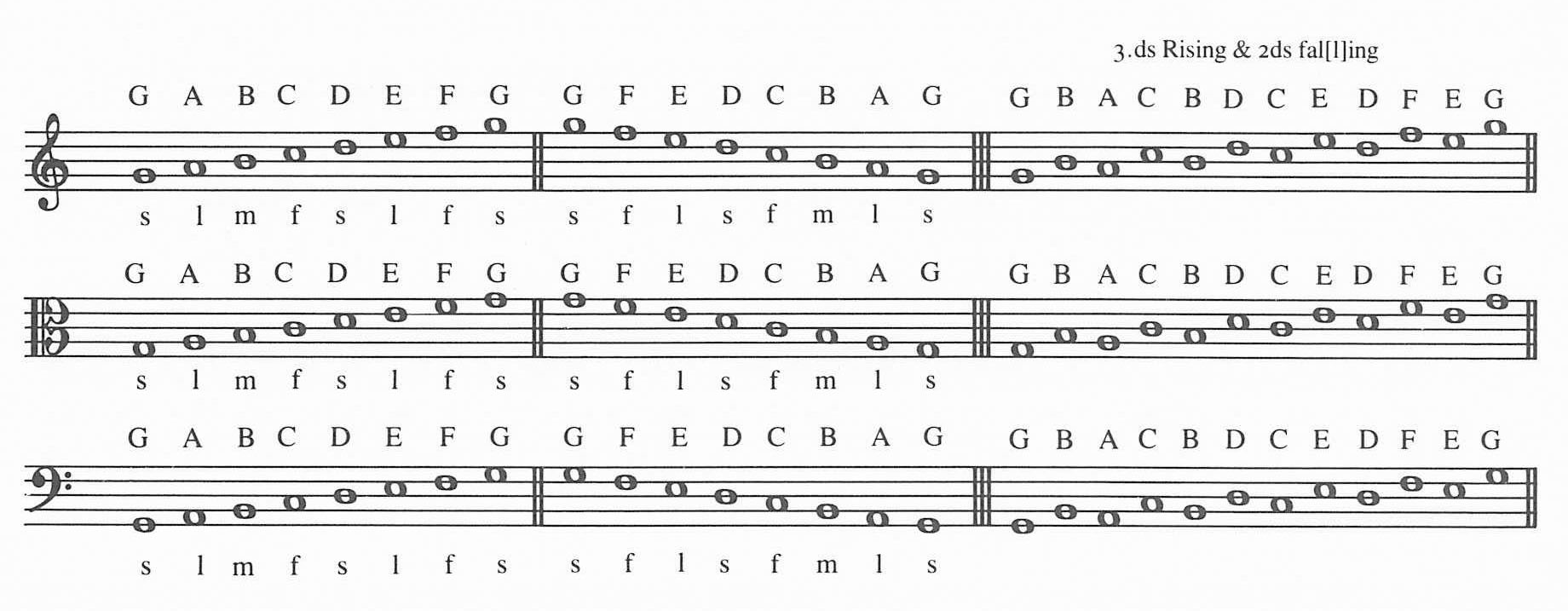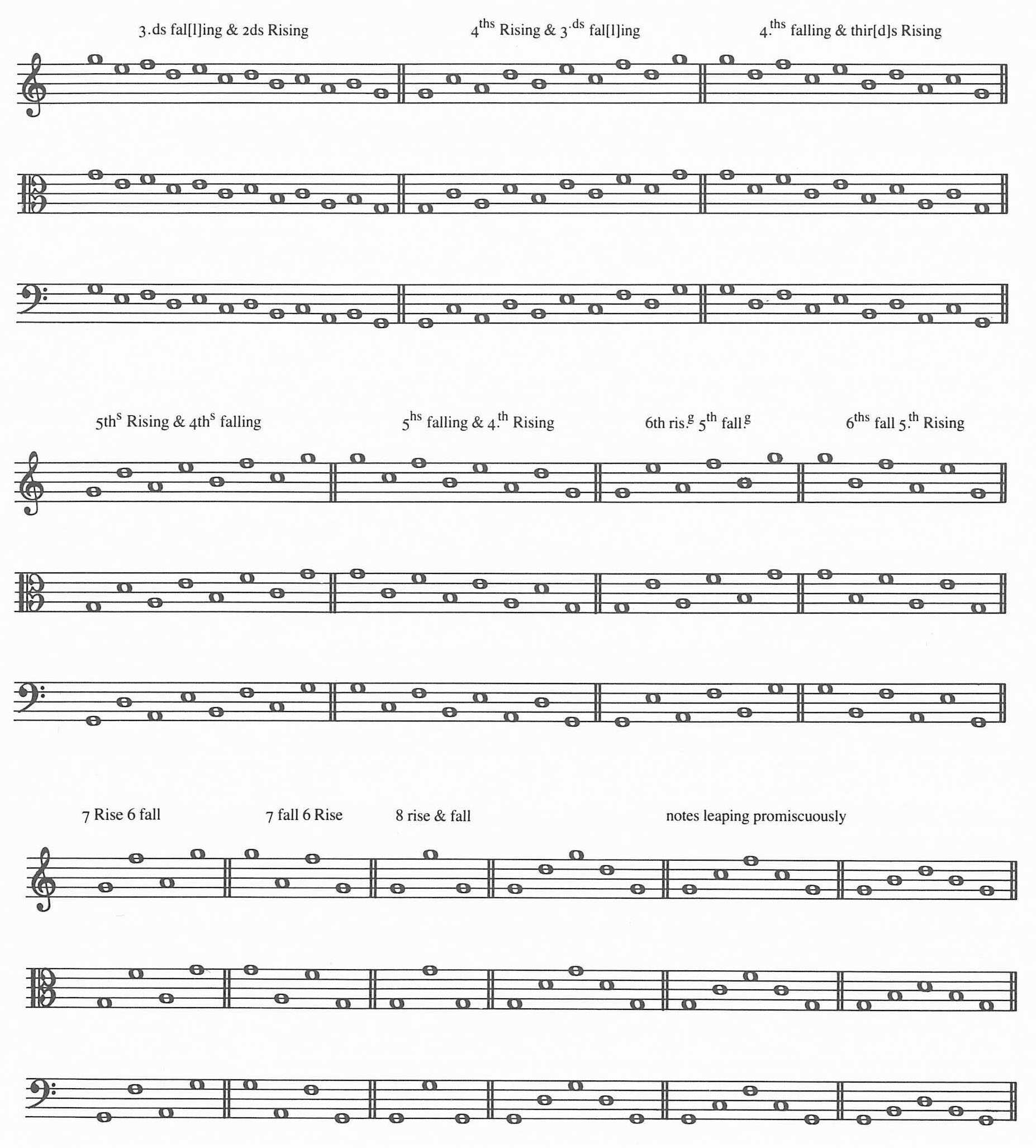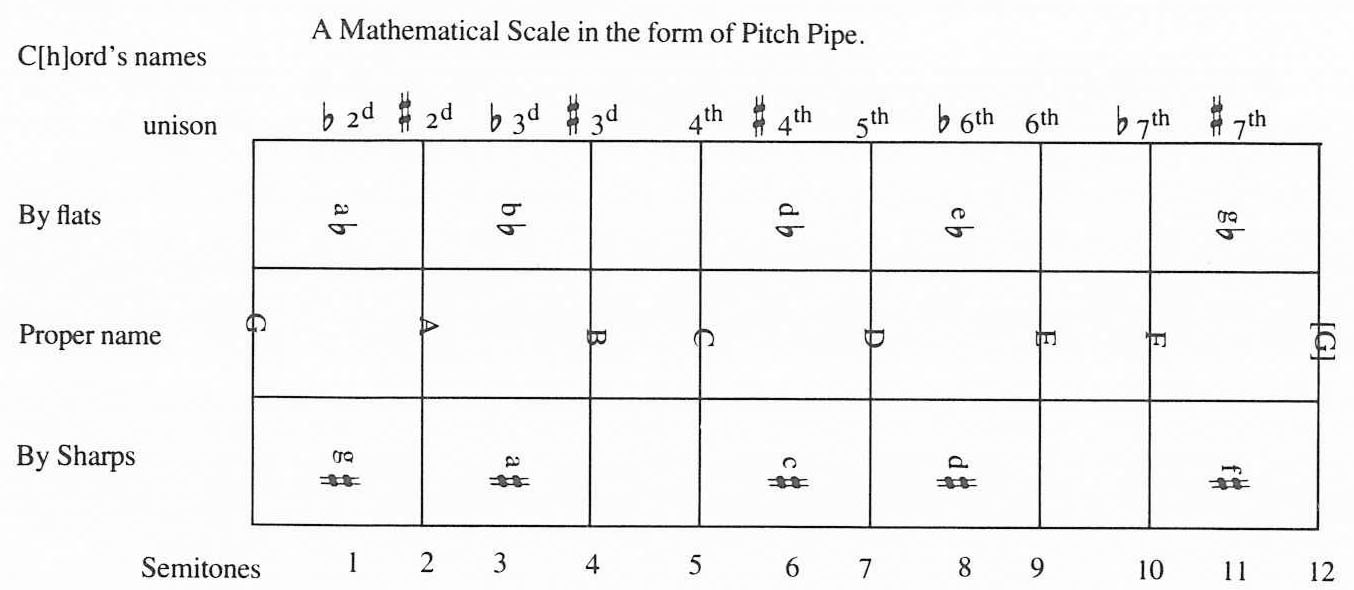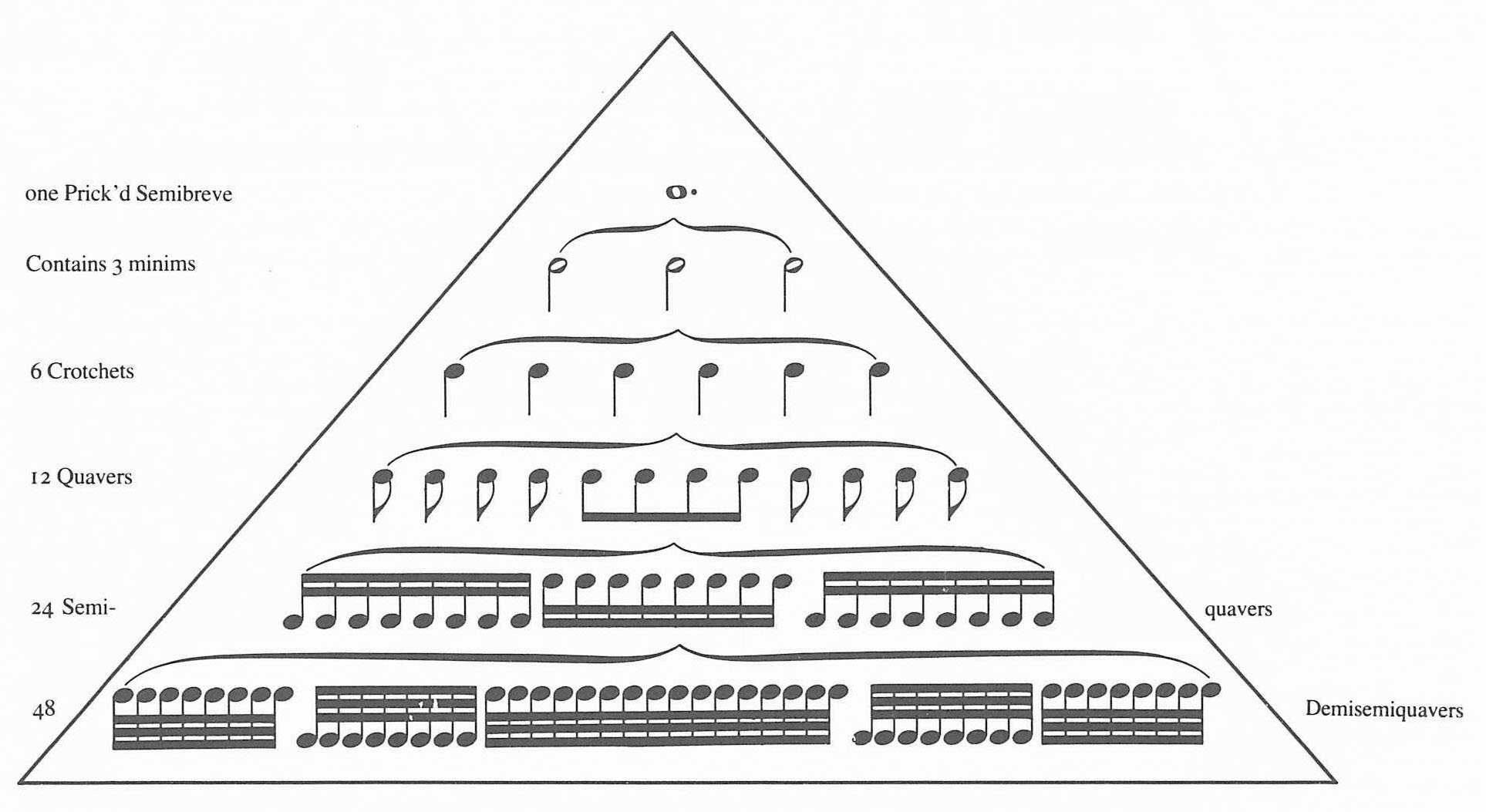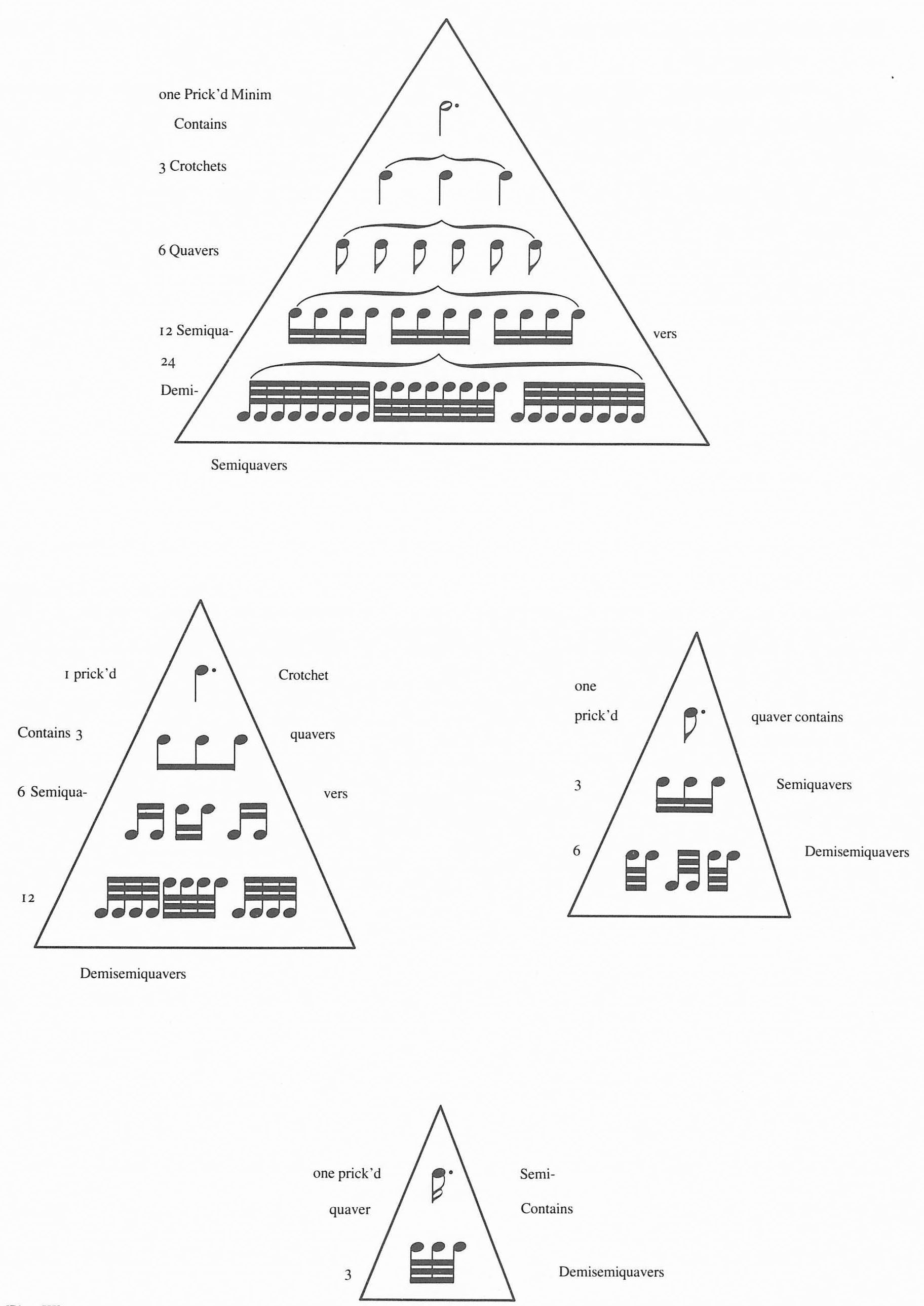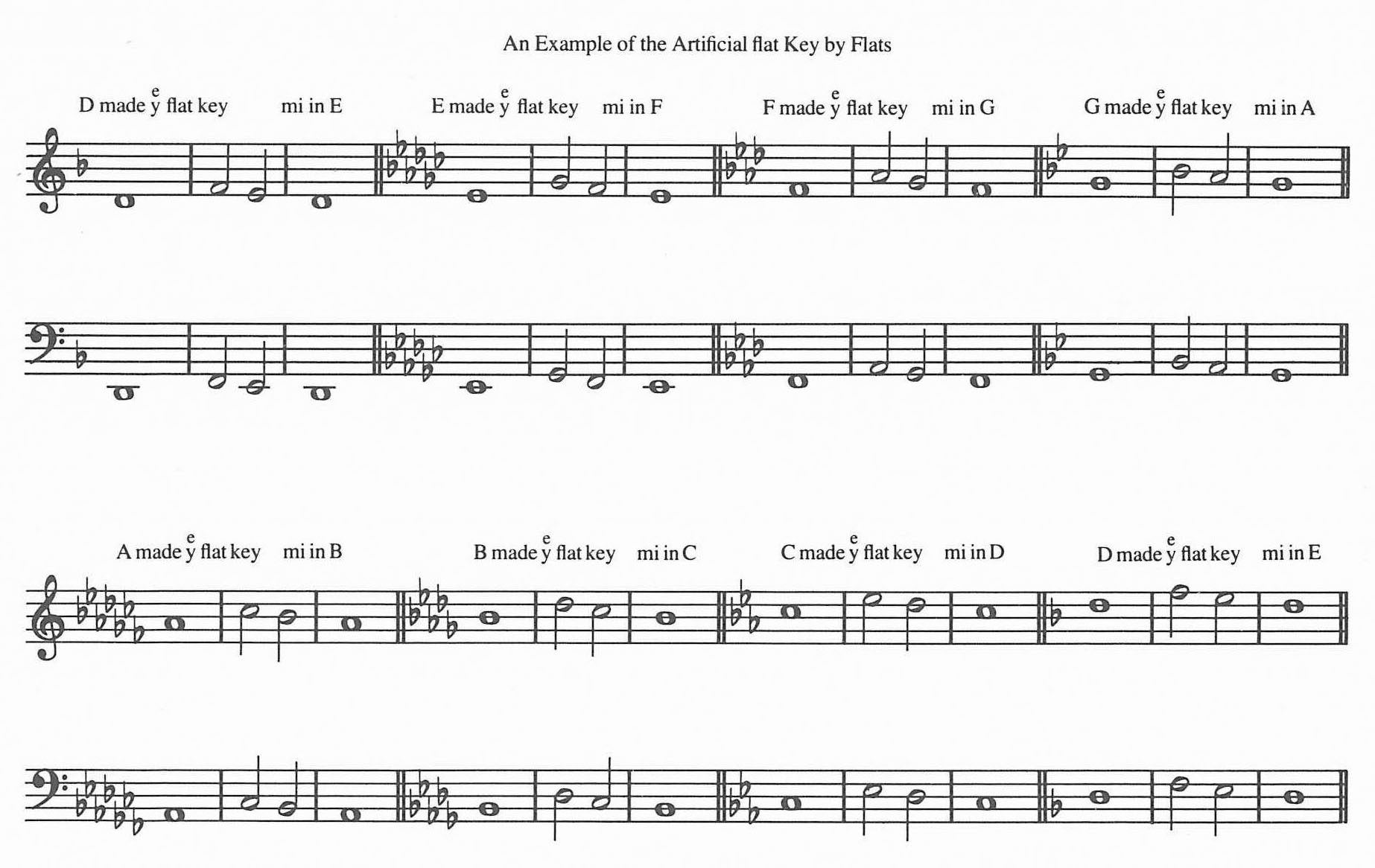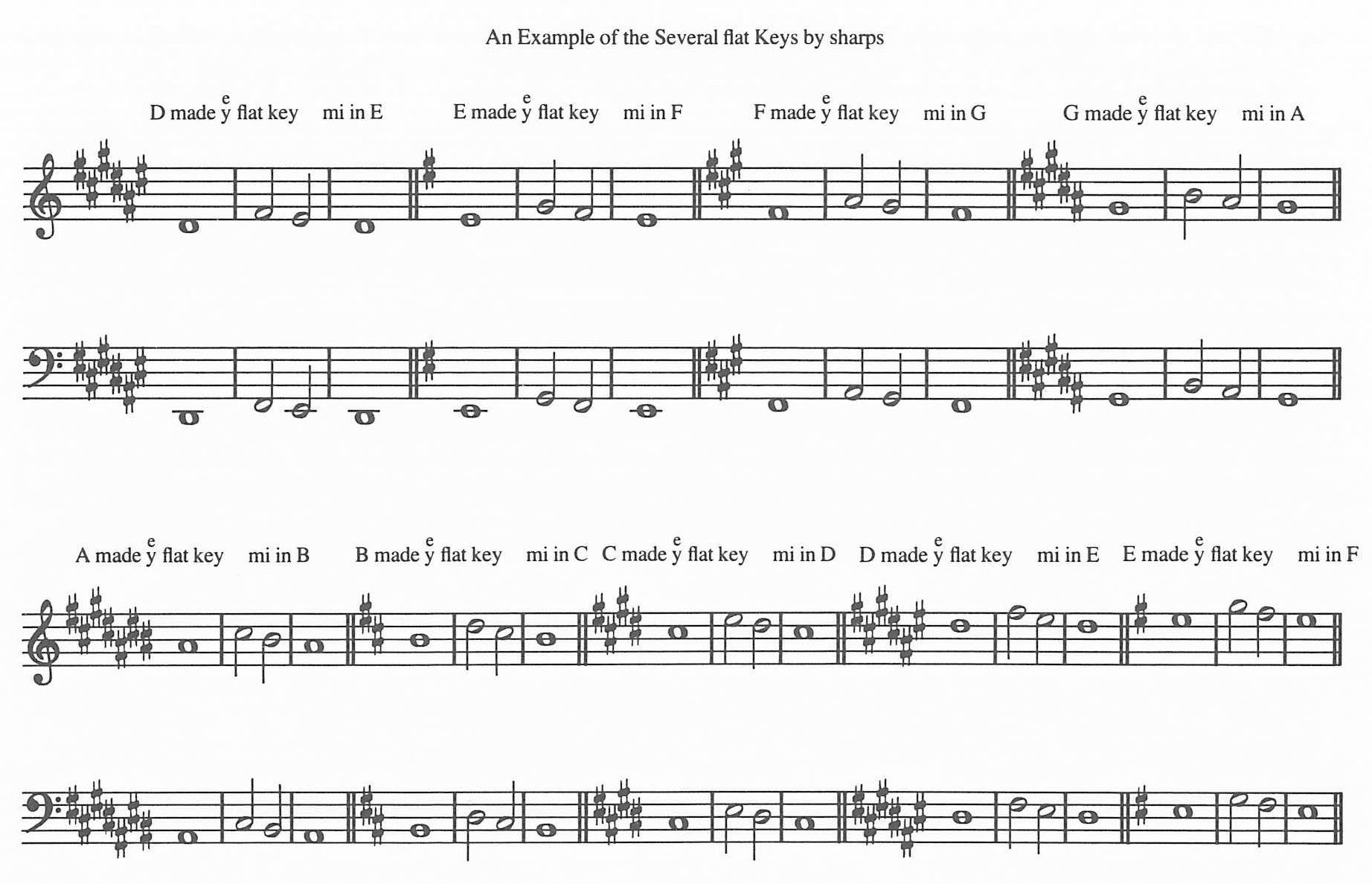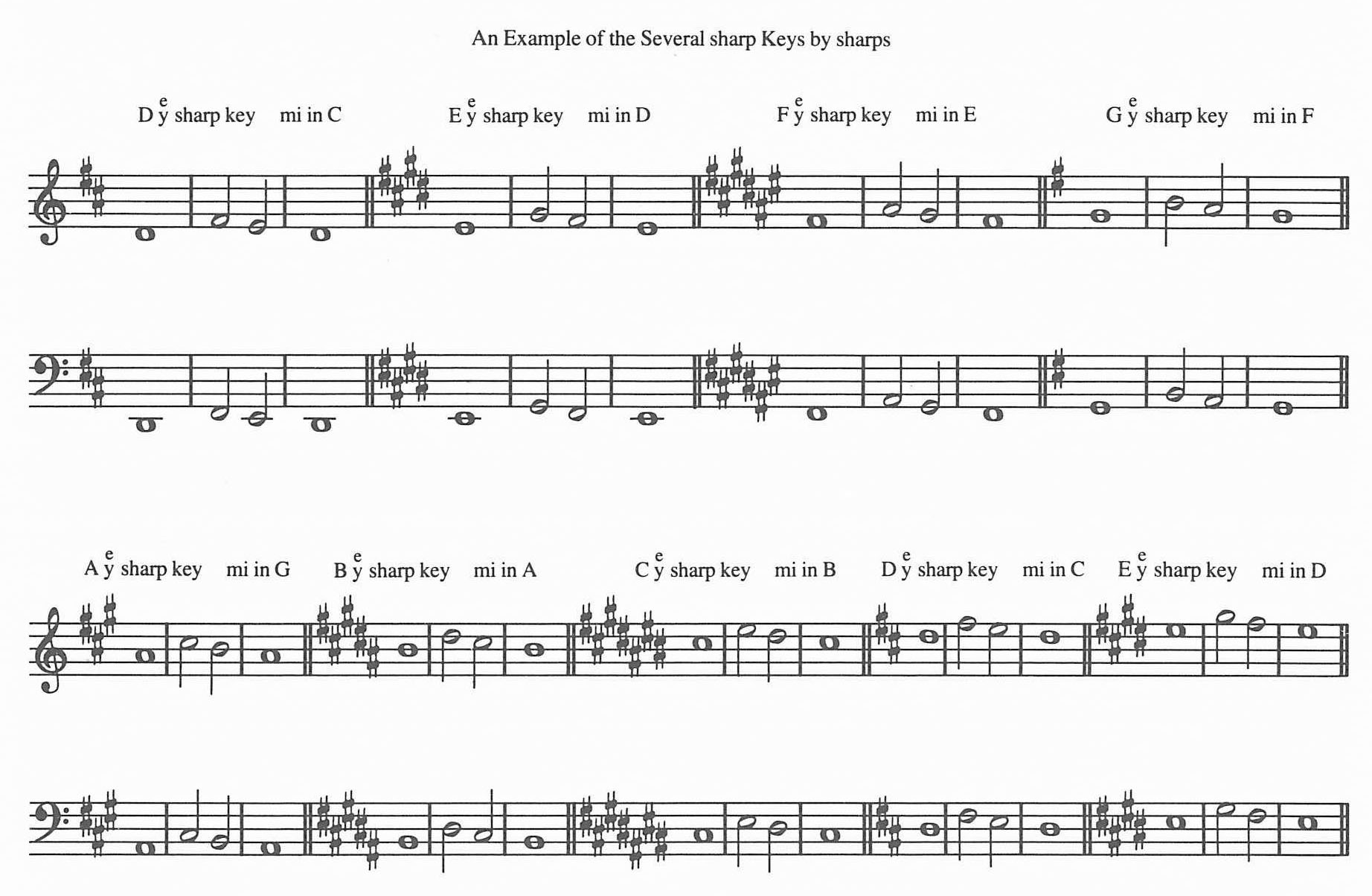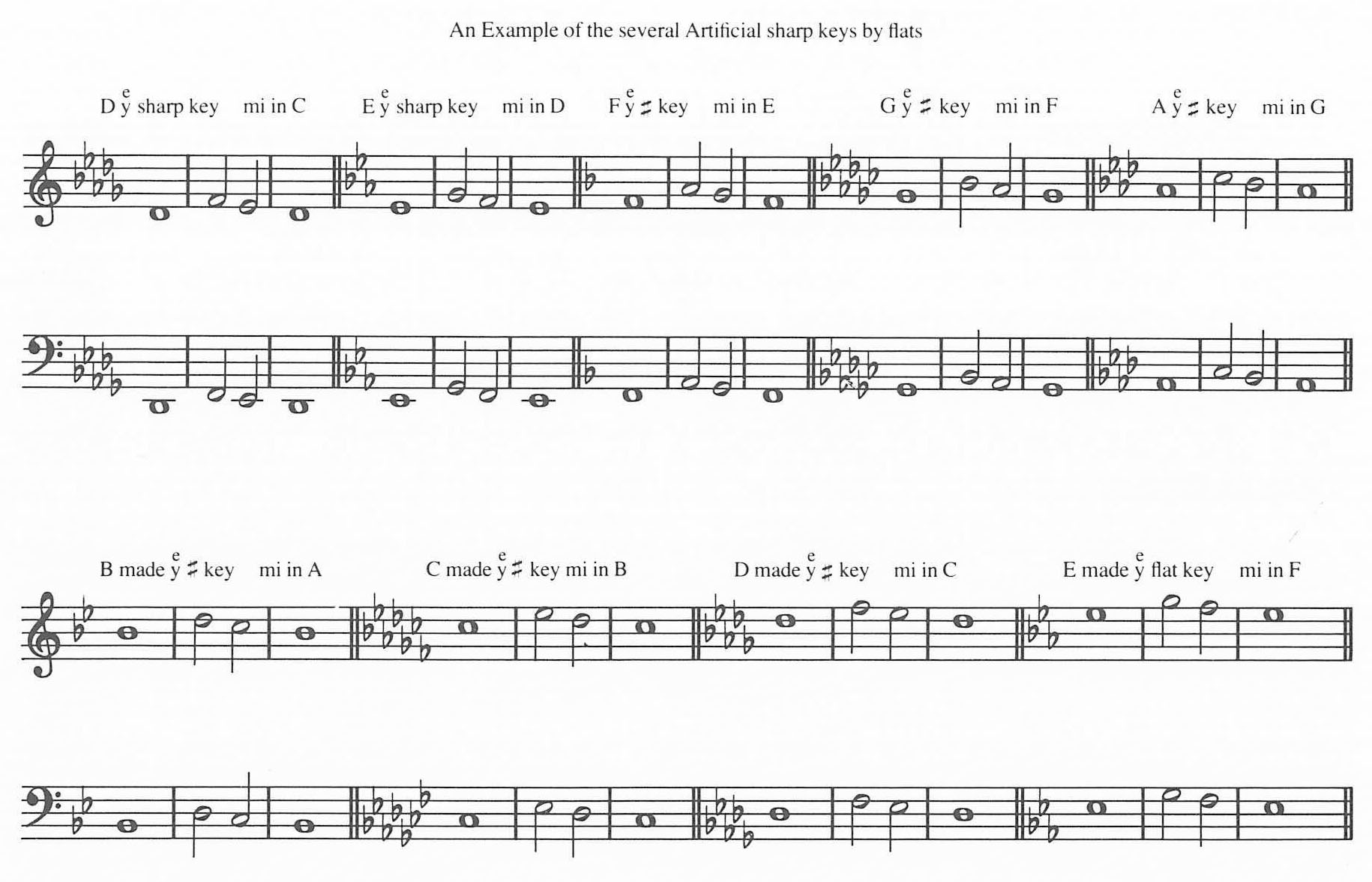Billings’s Introduction to The New-England Psalm-Singer
PREFACE
ALTHO this Composition hath cost me much Time and Pains; yet I little thought of exposing it to public View: But being repeatedly importuned by my Friends, I was at last prevailed upon to commit it to the Press. And such as it is I now offer it to the Public, from whom, should it meet with a favourable Reception, it would compensate for all the Trouble I have been at, and the Time I have spent in the Prosecution of it. Perhaps there may appear in the Eyes of the Accurate much Incorrectness that I was not able to discern; therefore [I] would beg the Critic to be tender, and rectify those Errors which through Inexperience may happen to have escaped the Notice of a Youth, in the Course of so large a Volume.
I would here take Occasion to return my Thanks to those Gentlemen who have put so much Confidence in this Performance, as to promote and encourage it by Subscription, before they could have an Opportunity of examining it. And I would acknowledge myself in a particular Manner obligated to that Gentleman who has honored me and this book with his learned Philosophical Essay on Sound; yet at the same Time I can’t but be sorry that I am not allowed to give the Public the Satisfaction of knowing his Name: For somewhat contrary to Nature, Modesty in this Gentleman, has so far gained the Ascendency over Ambition, that the World must remain deprived of the Knowledge of him, ’till his Name shall shine on the Page of some future Work.
It would be needless in me to attempt to set forth the Usefulness and Importance of Psalm-singing, which is so universally known and acknowledged, and on which depends no inconsiderable Part of the Divine Worship of our Churches. But thus much would I say, That he who finds himself gifted with a tunable Voice, and yet neglects to cultivate it, not only hides in the Earth a Talent of the highest Value, but robs himself of that peculiar Pleasure, of which they only are conscious who exercise that Faculty.
Authors in general, upon Subjects of this Nature, abound mostly in Tunes of common Metre; but in this Respect, I have deviated from them, endeavouring to have a Sufficiency in each Measure. In the Composition I have been as plain and simple as possible; and yet have tried to the utmost of my Power to preserve the modern Air and Manner of Singing. And should it upon Proof be found equal to the Attempt, I hope it will be as well an Inducement to the unskill’d in the Art to prosecute the Study of it, as an Entertainment to the more experienced in it.
Boston, October 7 1770
ADVERTISEMENT.
If this Work would meet with Encouragement, it may be an Inducement to the Author to publish another Volume, which he has in [his] Possession, consisting chiefly of Anthems, Fuges and Chorus’s, of his own Composition.
An ESSAY on the Nature and Properties of Sound.
[by Dr. Charles Stockbridge]
Music being nothing but particular Sounds, variously modified, and adapted to please the Ear, perhaps those, whose Ears are so constituted, as to delight in it, may not be unentertained with some Observations on the Nature of Sounds in general, more especially such, as are called Musical Tones.—The Doctrine of Sounds, is, in many Respects, the most intricate and perplexed, of any one Branch of natural Philosophy; and has puzzled the greatest Genius’s in the Explication of the Phaenomena relative thereto. I shall not here attempt to enter into the more abstruse Parts of it, such, as may require Mathematical Calculations in the Investigation of, but consider those Things, only, which are of principal Concernment, and at the same Time, not very difficult to comprehend; for, this Essay is designed only to give a general Notion of the Nature and Properties of Sound to those, who have not had the Advantages of a Philosophical Education.—Sound, considered abstractedly as a mere Perception of the Mind, admits not of Definition or Explanation; what is here principally to be considered, are those Circumstances, which must necessarily take Place in Nature, in order to produce in us the Idea of Sound.—It appears very evident from Experiments, that Sound, has a necessary dependence on the Air; for, in Places, from whence the Air is extracted, as in an exhausted Receiver, the most sonorous Bodies emit no Sound at all. The Air, therefore, may be considered, as the Subject, or Medium of Sound, without which, we never shou’d have the Perception of it. And, as the Air, is a Fluid whose Particles are specifically extremely light, and indued with the Property of Elasticity in a great Degree, it follows, that they make but a small Resistance, and are easily put into Motion by any impress’d Force; which Motion of the Air, will ever correspond with, and partake of, the same Kind, of the Motion of the moving Power. When, therefore, the Parts of an elastic Body by Percussion, are put into a tremulous, vibrating Motion (which Kind of Motion is natural to all elastic Bodies in recovering their natural State, after an impressing Force ceases to act) those tremulous Motions, communicate correspondent Vibrations, to the contiguous Particles of Air, they to others, and so on, till having arrived at a certain Distance from the tremulous Body, the Vibrations cease; being gradually destroyed, by a continual successive Propagation of Motion, to fresh Particles of Air, throughout their Progress.—A steady uniform Current of Air such as produces Wind, however strong, will not occasion Sound; but it is necessary there should be a tremulous, or reciprocal vibratory Motion, and that to a certain Degree of Quickness, in order to produce an audible Tone. This Matter will be best conceived of, by instancing in the Vibrations of a Musical Chord. When an elastic Chord or String sufficiently stretched, is pulled out of its rectilinear Situation by a Force applied; and then left to recover its natural State by its Power of Elasticity, it will produce a Number of Vibrations; that is it will pass and repass a Number of Times across the Line which it occupies in its quiescent State. These Vibrations, though they become shorter and shorter till the Chord is at perfect Rest, are all made in equal Times; that is, the first or longest Vibration, takes up no more Time than the last or shortest. Now, it must appear very evident, that the contiguous Particles of Air, being compelled to move forward by the first Impulse of the Chord in its first Vibration, propel those next to them, and these, others again, and so on to a considerable Distance according to the Intensity of the percussive Force. But when the Chord makes the second Part of the Vibration, by returning back again, the Particles of Air also, by their repulsive Power, repel each other toward their proper Places, and thus again expand themselves; and thus there will be a continual Condensation and Expansion of the Air, at every compleat Vibration of the Chord. Whence it will appear evident, that there must be the same Number of Tremors or Vibrations of the Air, that the sonorous Body makes. These reciprocal Tremors of the Air, made by the Vibrations of an elastic Body[,] succeed each other in an undulatory or wave-like Manner, analogus [sic] to Waves generated in the Surface of stagnant Water by an impressed Force, and spread themselves around in every Direction, in concentrec [sic] Spheres, whose Centre is the sonorous Body. And it frequently happens, that in their Progress from the sounding Body which is their Centre, that they meet with various resisting Objects, upon which they are impinged, which will reflect them back, and so cause new Vibrations of the same Kind the Contrary Way. If the resisting Odject [sic] is a little more than 500 Feet distant, the reflected Sound will be distinctly heard, because it will take up near a second of Time in its Access and Recess. But if the Distance be much less, the reflected Sound will so nearly coincide with the original as not to be distinguished from it. This may be observed in Churches where, though the Voice of the Speaker suffers a vast Number of Reflections from the Roof, Floor, and Walls, yet they so mix themselves together with the original Voice, as not to be distinguished from it, but only render it stronger. These reflected Sounds constitute what is called an Eccho [sic]; and the greater the Distance of the reflecting Object, the longer in Proportion to that Distance will the Time be, before the Repetition of the Sound will be heard: And when the Sound in its Progress meets with Objects at different Distances sufficient to produce an Eccho, the same Sound will be repeated several Times successively, according to the different Distances of these Objects from the sounding Body; which makes what is called a repeated Eccho. Sound is subject to the same Laws in its Reflection, that Light and Heat are, the Angle of Reflection in both Cases, being the same as the Angle of Incidence; and therefore it is easy to determine where the Eccho will be most distinctly heard when the Figure of the reflecting Surface, and the Situation of the sounding Body are known.—If Sound is impressed upon a Column of Air, contained in a long narrow, but diverging Tube such as the common Speaking Trumpet, it will be continually reflected and reverberated from the curved Sides, into the Axis, whereby it becomes more intense at its Exit, and will consequently be much louder, and be heard at a much greater Distance than otherwise it wou’d be. So likewise if the narrow End be applied to the Ear, and the broad End directed towards the Body which emits the Sound, the sonorous Rays (as they may be called) will be collected, converged, and strike the Drum of the Ear with greater Force, in Proportion, as the Diameter of the broad End, is greater than the narrow.—The Velocity of the aerial Waves, or of Sound, is equible [sic] and uniform, and ceteris paribus, will pass over Spaces proportional to the Times; that is, double the Space, in double the Time, and so on. Adverse or conspiring Winds make but a small Difference in the Velocity of Sounds, (tho’ very considerable in their Loudness) too small to be distinguished in several Miles, tho’ in great Distances the Difference is sensible. All Sounds, proceeding from whatever sonorous Bodies, whether intense or weak, grave or acute, move with the same Degree of Velocity, which is at the Rate of 1142 Feet per Second, or nearly a Mile in 4½ Seconds. The Distance to which Sounds may be heard depends upon many concurring Circumstances, viz. First, the Intensity of the Stroke made on the tremulous Body emitting the Sound; for, the greater the Stroke is, the greater will be the Agitation of the Particles of the sonorous Body, and consequently the greater will be the Force with which they will impress the contiguous Particles of Air; and the greater the Force is impressed upon Air, the more closely will it be condensed, and with greater Violence expanded; hence the greater will be the Stroke at any given Distance on the Drum of the Ear, and consequently the greater will be the Distance at which the Agitation of the Air, will be sensible. Secondly, the Density of the Air; for the more dense the Air is, the louder will the Sound be from the same Cause; and, as the Loudness of the Sound depends upon the Magnitude of the Force impressed upon the Air, by the tremulous Body, it follows, that the more dense the Air is, the greater will be the Force impressed upon the Air, by a tremulous Body agitated with the same Degree of Violence, and consequently the Sound will be heard at a greater Distance. Thirdly, conspiring Winds; for as the Particles of Air contiguous to the sonorous Body, receive a certain Quantity of Motion at each Vibration of the Body, they communicate Motion to those next [to] them, they to others, and so on successively; but, as the circular Waves continually increase in their Surface as they depart from the Center, they must consequently communicate Motion to larger Portions of Air, so that the Force not the Velocity of their Motions must constantly decrease, till finally it will be so far lost, as not to be perceptible to the Ear; this takes place in a perfect Calm: But when a current of Air conspires with this undulatory Motion, it meets with less Resistance, and consequently will have the same Force, and be audible at a greater Distance. There are numerous Experiments by which it has been found, that Sound is audible, Sixty or Eighty Miles: And in the Fight between England and Holland a.d. 1662, the Report of the Cannon was heard at the Distance of 200 Miles.
In order the more effectually to comprehend the Nature of Sound, and conceive of the Manner in which that Perception is excited in the Mind, it will be necessary to have some Knowledge of the Mechanism of the Ear, which, of all the Organs of Sense[,] is the most wonderful and complex. I shall not here attempt an exact anatomical Description of the Ear, but consider it so far only, as may be necessary in some Degree to ascertain the Modus of Hearing.—The external Part of the Ear, or that which is without the Head, is most curiously contrived to collect the sonorous Rays (in like Manner as a concave Mirror collects the Rays of the Sun) which meets in a Focus at the Entrance of the Meatus auditorius, or Passage which leads directly into the Head to the internal Ear, by which means the most obscure Sounds may be rendered audible. The Meatus auditorius is a Tube composed partly of Cartilage, partly of Bone, lined with a smooth nervous Membrane defended with a viscid Water and Wax; whence, it is extremely well adapted to convey Sounds from without, inward without corrupting them. In its Course inward, it proceeds not in a strait Line, but first ascends, then descends, then ascends again in a serpentine Manner till it terminates in the Membrane of the Tympanum, or Drum of the Ear; which winding Course, by increasing its Length, serves to increase the Number of Reflections, and Loudness of the Sounds. At the End of the Meatus auditorius, there is a fine nervous Membrane spread across, called the Membrana Tympani, or Membrane of the Tympanum; upon the Center of which, the tremulous Concussions of the Air, after various Reflections and Reverberations through the Meatus auditorius, are impinged. Under this Membrane, is the cavity of the Tympanum, which contains a Portion of common Air, but has no natural Communication with the external Ear; there is a tube which leads from thence, into the Mouth behind the Tonsils; by means of which, the Air from the Tympanum, may be expelled, or fresh Air admitted. Under the Membrane of the Tympanum, there is a Nerve extended across, in like Manner that Chords are extended across the Parchment of the Bottom of a Drum. The Membrane of the Tympanum, is furnished with proper Muscles, by means of which, it may be strained or relaxed, according to the variety of Sounds, that it may be capable of coming into Unison, or correspond Harmonically, to all Sounds; otherwise, it would be affected with only one Sound, namely, that, with which, it was in Concord. There are in the Labyrinth of the Ear, four little Bones furnished with proper Muscles, very useful in the Operation of Hearing. These are called the Malleus, the Incus, the Os Orbiculare, and the Stapes. The Membrane of the Tympanum is connected with the Handle of the Malleus, which is articulated with the Incus; the Incus is connected with the Os Orbiculare, and Stapes; which last, by Means of a Membrane, adheres to the Fenestra Ovalis. The Fenestra Ovalis, is an opening into another Cavity of the Ear, called the Vestibulum; the lesser Part of which, communicates with the superiour Part of the Cochlea. The Cochlea, is a hollow spiral Body, containing two Circumvolutions and a half, in order to increase its Length; the Necessity of which, will, by and by[,] be perceived, in its Use; it is the inmost Cavity of the Ear, and properly the Place, where Sounds are the most distinctly impressed upon the auditory1 Nerve. The auditory Nerve, enters into the Vestibulum by several little Holes, and forms a curious Lining all over the inside Surface of it. These Nerves also, pass into the Cochlea; and branch themselves out into an exquisite Membranous Expansion on each Side of the same, which thus becomes the more immediate Organ of Hearing. The Cavity of the Vestibulum is always filled with an elastic Air, tho’ there appears no visible Way by which it can enter.
Having thus premised a Description of the Organ of Hearing, we shall better conceive the Nature of, and the Manner in which, Sounds are excited in the Mind. When the Air is put into a tremulous Motion by the Vibrations of a sonorous Body, the sonorous Rays are collected by the external Ear, and concentered into a Focus, at the Entrance of the Meatus auditorius, where they are condensed by various Reflections through that Passage, to their Incidence on the Membrana Tympani; which, being actuated by its proper Muscles for that Purpose, is rendered more or less lax or tense, as the Tone of the Sound is more or less acute or grave, and thus be fitly adapted to vibrate in Correspondence with the vibrating Body. This Membrane being connected with the Malleus, will excite that into harmonical Tremors; and the Incus being connected with the Malleus, must be agitated in the same Manner, and communicate the like Tremors to the Os Orbiculare, and Stapes; and the Membrane which shuts the Fenestra Ovalis, being contiguous to the Stapes, must suffer the like Agitations, which will be communicated to the elastic Air in the Vestibulum, and Cochlea, and consequently to the auditory Nerve itself. The Membrane which shuts the Fenestra Ovalis, by a curious Apparatus of the Parts, in like Manner as the Membrane of the Tympanum, may be intended, or remitted, in a vast Variety of Degrees, so as to be adapted for every Sort and Degree of Sound; and for communicating them to the internal Air, which affects the Nerves expanded over the internal Surface of the Vestibulum and Cochlea, with similar and corresponding Tremors. There is something extremely curious in the Expansion of the Nerves over the spiral Fabric of the Cochlea; for they are contrived, like so many Strings of an Harpsichord, of various decreasing Lengths, and different Octaves, that so, some or other of them, may be of a proper Length to be in Concord with the sounding Body, and to tremble with the same Vibration; which, by the Continuation of the Nerves, are conveyed to the common Sensory in the Brain, where the Mind perceives, and distinguishes the infinite Differences of harmonious and discording Tones. Having treated thus far of the Nature of Sounds in general, the Organ of Hearing, and the Manner in which Sounds are impressed upon that Organ, I shall now add some few Observations on those particular Sounds, called harmonious or musical Tones.
When the Air is uniformly agitated by an homogeneous elastic Body for a Length of Time sufficient to gain the Attention, it constitutes a musical Tone or Sound, which will be either acute or grave in Proportion to the Number of Vibrations performed in a given Time. The quicker the Succession of the Vibrations is, the more acute is the Tone and è contra. But these reciprocal Tremors of the Air must be to a certain determinate Degree of Quickness in order to produce Sound. For if there are fewer than five or six Hundred in the Space of a Second of Time, they will not produce Sound to a human Ear; about that Number being the gravest audible Tone; and on the other Hand, if more than six or seven Thousand, succeed each other in the same Space of Time, no Sound will be produced in us; because, corresponding Tremors, or Vibrations, in the Organ of Hearing, cannot take Place. All Sounds, from the loudest to the lowest, which proceed from the Vibrations of the same Body, are of the same Tone; the Magnitude of the Stroke, upon the sonorous Body, though it increases the Loudness of the Sound, yet adds not to the Acuteness of it, because, the Vibrations are made in equal Times, and the Times of the Vibrations, are what constitute the Acuteness or Gravity of the Sound. Therefore, all sonorous Bodies of whatever Kind, or Nature, which produce an equal Number of Vibrations in the same Time, will yield one and the same Tone called an Unison, which is the most perfect Concord. In this Case, the Number of Vibrations, though performed by a Variety of Bodies perfectly coinciding, the Air will be uniformly agitated, and affect the Ear with a simple Sound, increased only in Loudness by the Number of sonorous Bodies. In Truth and Fact, this is very generally the Case with what we call simple Sounds; for let any Sound be made, either with the Voice, or any sonorous Body, every other sonorous Body near it, and in Unison with it, that is, such as perform an equal Number of Vibrations in the same Time, will be thereby made to Sound. For the Vibrations of the Air, which correspond to the Tremors of the first sounding Body, agreeing exactly in Point of Time, with those, which are capable of being given to the other Body in Unison with it, when they have, by their Impulse communicated a small Degree of Motion to it, will, by conspiring with it, as it moves backwards and forward, continually increase its Motion, till it becomes sensible. So that the greater Number of sonorous Bodies there are in Unison with the first sounding Body, and near enough to be sensibly affected with its Tremors, the louder will the Sound be; and will seem to the Ear, to be a simple unmixt Sound. And, not only those Bodies, which are in Unison with the first sounding Body, but Bodies which naturally yield a Tone an Octave, Fifth, or Third, greater or lesser, more grave or acute than the first sounding Body, will be made to tremble and yield their natural Tone in Concord with the first, though not in equal Degree with a perfect Unison. But, when sonorous Bodies are in Discord with each other, that is, when their Vibrations are not performed in equal Times, or in Octave, Fifth, or Third, greater or lesser, the Reverse of this will take Place. For, though the first Vibration of one, may give Motion to the rest, yet as they are unequal in the Times of their Vibrations, and not within the Reach of concording Vibrations, there will be a crossing of Motions more or less according to the inequality; by reason of which, the Motions of the untouched Bodies, will be so checked, as never to be sensible. With respect to two Musical Chords of the same Species of Matter, stretched with the same Degree of Force, and of the same Magnitude, but one double the Length of the other, it may be observed, that the longer naturally yields a Tone one Octave lower than the shorter; by reason of its making but half the Number of Vibrations in the same time, but if the shorter be made to sound, the two Extreams [sic] of the longer, if within a proper Distance, will each sound in Unison with it, while the middle Point remain[s] at Rest. So likewise, if one be thrice the Length of the other, and under the same Circumstances, beforementioned, if the shorter be made to vibrate, the other will be divided into three Parts, each of which will sound an Unison with the shorter, and the two Points between those Parts, will remain at Rest. And unless this was to take Place, that Chord which vibrates twice, while the other once, must necessarily interfere with it at every second Vibration; and that which vibrates thrice, while the other once, wou’d interfere with it at every third; so that it would not be put into a sufficient motion to produce Sound. But, when it is divided by the quiescent Points, it becomes so many Chords at Unison with the former, each of which easily receives its Vibrations from thence. — — Thus we have attained the Idea of a most perfect Concord, called an Unison, which is no more than an exact Correspondence of the Vibrations of sonorous Bodies, respecting Time; for the Ground and Reason of Concordance among Musical Sounds, is, the Coincidences of the Vibrations of sonorous Bodies. The next most perfect Concord, is what is called the Octave, and differs from an Unison in this, that in two Musical Chords or Strings, the one which yields a Tone an Octave more acute than the other, it performs double the Number of Vibrations in the same Time; whereas in an Unison, the same Number is performed in the same Time. An Octave comes the nearest to an Unison, of any possible Sound in Nature; and therefore is called the next most perfect Concord; because the more acute Octave, makes precisely two Vibrations while the more grave or deep one, makes one; consequently there is a Coincidence at every Vibration of the grave, and at every other of the acute. Hence Unison and Octave, by reason of their near Resemblance, have been mistaken for one and the same Sound. When the Times of the Vibrations of two Musical Chords, are as two to three, the Coincidence will be at every third Vibrations of the quickest; which is therefore in the next Degree of Perfection, and called a Fifth. If the Times of the Vibrations, are, as three to four, the Coincidence will be at every fourth of the lesser; and this is called a Fourth. But this, and the two next which follow in order, viz. four to five, and five to six, which make the Third greater and Third lesser, are not so pleasant and agreeable to the judicious Ear; and are therefore called imperfect Concords. If the Coincidences become less frequent than these, the Consonance is intolerable to a Musical Ear, and constitutes what is called Discord. The difference, therefore, between Concord and Discord among Sounds, seems to arise, from the different Proportions of the Vibrations of sonorous Bodies; that is, from the frequency of the Coincidences of their Vibrations. The more frequent the Vibrations of two Musical Chords coincide, the more perfect the Concord, and the more agreeable to the Ear, is the compound Sound; and, vice versa. But, the essential Difference between Concord and Discord; that is, the Reason why the one shou’d be agreeable, the other disagreeable, seems to be beyond the Reach of natural Philosophy to account for. There does not appear any natural Aptitude in the two Sounds of a Concord, to give a pleasing Sensation, more than in two of a Discord; this must be released into the Divine Will, which, has thought proper to impress us, with pleasing or displeasing Perceptions, from those particular Circumstances of Sound. We know from Experience, what Proportion of Vibrations are pleasing, and, what not; and we know likewise how to express their Difference by the Proportion of Numbers. We know what is pleasing, tho’ we do not know why, for Instance, we know that the Ratios of one to two which we call an Octave, constitute a Concord, and six to seven a Discord; but on what original System, pleasing or displeasing Ideas, are connected with those relations, seems to be above the Reach of our Faculties to determine.
The following Ratios, or Comparisons, of the Lengths of Chords, of the same Diameters, and stretched with equal Forces will be Concords, viz. 2 to 1,3 to 2,4 to 3,5 to 4,6 to 5,5 to 3, and 8 to 5; that is, by taking any Chord for a Fundamental, represented by 1, the following Divisions thereof will be all Concords with the whole; a 1/2, 2/3, 3/4, 4/5, 5/6, 3/5, 5/8.—I will here subjoin a Table of all the Concords, between the Ratio of Unison, or 1 to 1, and the Octave 2 to 1; expressing the Ratio’s [sic] or Comparisons of the Lengths of the Chords, and their Vibrations, the Frequency of their Coincidences with the fundamental or gravest Tone, Names expressing their Intervals, and Degrees of Perfection.
| Length | Vibrat: | Coin. | Names | |
|---|---|---|---|---|
|
1 to 1 |
1 to 1 |
1 |
Unison |
Most perfect. |
|
6 to 5 |
5 to 6 |
5 |
Third lesser. |
Imperfect. |
|
5 to 4 |
4 to 5 |
4 |
Third greater. |
Imperfect. |
|
4 to 3 |
3 to 4 |
3 |
Fourth. |
Imperfect. |
|
3 to 2 |
2 to 3 |
2 |
Fifth. |
Perfect. |
|
8 to 5 |
5 to 8 |
5 |
Sixth lesser. |
Imperfect. |
|
5 to 3 |
3 to 5 |
3 |
Sixth greater. |
Imperfect. |
|
2 to 1 |
1 to 2 |
1 |
Octave. |
Perfect. |
This Table wants but little Explanation; take the example of the Fifth; the Length of the Chords sounding this Concord, must be as 3 to 2, the Vibrations will be as 2 to 3, the Coincidence of their Vibrations, will be at every second Vibration of the Fundamental, or slowest vibrating Chord, it is called a Fifth, as being the fifth Note from the Fundamental, or Key-Note inclusive; and is the next perfect Concord to an Octave; as will readily appear from an Inspection of the Table. By this Table it will appear, that in Concords the greatest Number of Vibrations of the Fundamental cannot exceed five; that is, there will be no Concord where the Fundamental makes more than five Vibrations of one Coincidence of the acute Term.
Among the many wonderful Effects, which are said to be produced by Musick, none is more extraordinary than that which it has on those, who have been bit by the Tarantula. As there is something curious in the Account given of it by good Authority, perhaps a short Relation may not be unacceptable. The Tarantula, is a large Spider, about three quarters of an Inch long, and as big as one’s little Finger; they are Natives of Aupulia in the Kingdom of Naples in Italy. They are not venomous, but in hot Weather; at which Time, whoever is bit by them after some Time loses both Sense and Motion, and dies if destitute of Help. The most effectual Remedy is Music. The Musician tries a Variety of Airs, till he hits upon one, that effects [sic] the Patient, who upon that begins to move by Degrees; first keeps Time with his Fingers, Arms, and Legs, afterwards is violently agitated in every Part of his Body; and then leaps up, begins to dance, and increases in Activity every Moment; till after five or six Hours, being very much fatigued, he is put to Bed and left to sweat. The next Day the same Air brings him out of Bed for a new Dance. Which Exercise being thus continued, the Distemper is abated in the Space of four or five Days; the Effects of the Bite being in some measure carried off by Sweat, and the Patient begins then to recover his Sense and Knowledge by little and little. The Cure seems to be for a Season only, for the Symtoms [sic] come on again about the same Time the next Year; and are again carried off in the same Manner; and if they should neglect to carry off this Relapse by Music and Dancing, they fall into incurable Disorders of which they in a few Years die. As Music is the common Cure, so they who are bitten are pleased, some with one sort of it, and some with another; one is pleased with a Pipe, another with a Timbrel, one with a Harp, and another with a Fiddle; so that the Musicians sometimes make several Essays before they can accommodate their Art to the Venom: but this is constant and certain, notwithstanding this Variety, that they all require the quickest and briskest Tunes; and are never moved by a slow dull Harmony.
The Reason that is given why the Patient is thus affected by Music, is because the Nerves of his Body are so disposed in that Distemper, as easily to be agitated by the Vibrations which are occasioned by the Principle [sic] and stronger Notes of what is played.
On MUSIC.
From a Miscellany of the Rev. Dr. BYLES
Down steers the Bass with grave Majestic Air,
And up the Treble mounts with shrill Career;
With softer Sound, in mild Melodious Maze,
Warbling between the Tenor gently Plays:
But if th’aspiring Altus join its Force,
See! like the Lark, it Wings its tow’ring Course;
Thro’ Harmony’s sublimest Sphere it flies,
And to Angelic Accents seems to rise;
From the bold Height it hails the echoing Bass,
Which swells to meet, and mix in close Embrace.
Tho’ diff’rent Systems all the parts divide,
With Music’s Chords the distant Notes are ty’d;
And Sympathetick Strains enchanting winde
Their restless Race, till all the Parts are join’d:
Then rolls the Rapture thro’ the Air around
In the full Magic Melody of Sound.
An Introduction to the Rules of MUSICK,
With such Directions for Singing, as is most easy and necessary for Learners.
Contents of Book i.
CHAP. III. Containing Rules for tuning the Voice; also an Explanation of a Concert Pitch-Pipe.
CHAP. V. Containing some other Characters made Use of in Musick; and their Explanation.
CHAP. VIII. Containing an Example of Concords and Discords.
CHAP. IX. Containing some thoughts upon Musick.
CHAP. I.
Explanation of the GAMUT.
THE Gamut is founded on no more than Seven Letters, viz. ABCDEFG, all above or below these are the same repeated over again, there being but Seven distinct Sounds in Nature, every Eighth or Octave being the same.
Observe, That in the first Column of this Gamut [see Plate I] Mi is in B, in the Second Column B is Flat, M[i] is in E, the Third Column B and E Flat, Mi is in A, the Fourth Column B. E. & A Flat, Mi is in D, the Fifth Column B. E. A. and D Flat, Mi is in G, the Sixth Column B. E. A. D. and G Flat, Mi is in C, the Seventh Column B. E. A. D. G. and C Flat, Mi is in F, the Eighth Column B. E. A. D. G. C. and F Flat, Mi is in B, which brings Mi into its Natural Place, according to the Poet.
By Flats the Mi is Driven Round,
Till forc’d in B, to stand its Ground.
In the Ninth Column F is Sharp, Mi is in F, the Tenth Column F and C is Sharp, Mi is in C, the Eleventh Column F. C. and G is Sharp, Mi is in G, the Twelfth Column F. C. G. and D is Sharp, Mi is in D, the Thirteenth Column F. C. G. D. and A is Sharp, Mi is in A, the Fourteenth Column F. C. G. D. A. and E is Sharp, Mi is in E, the Fifteenth Column F. C. G. D. A. E and B is Sharp, Mi is in B, which again brings Mi into its Natural Place, as the poet expresses it,
By Sharps the Mi’s led through the Keys,
Till brought Home to its Native Place.
Thus you have an Example of the Transportation of B. Mi through the Seven Letters both by Flats, and Sharps, which is as Extensive as possibly can be.
But three Flats and three Sharps is as many as is generally used, as thus,
THE SCHEME.
|
The Natural Place for Mi is in B, but |
|||||
|
if B |
|
be Flat Mi is in |
|
E |
|
|
if B & E |
be Flat Mi is in |
A |
|||
|
if B E & A |
be Flat Mi is in |
D |
|||
|
And |
|||||
|
if F |
|
be Sharp Mi is in |
|
F |
|
|
if F & C |
be Sharp Mi is in |
C |
|||
|
if F C & G |
be Sharp Mi is in |
G |
|||
And when you have found Mi in any of these Variations the Notes above are Fa, Sol, La, Fa, Sol, La, and below are La, Sol, Fa, La, Sol, Fa, then comes Mi again.
In order to make you more Expeditious in finding your Mi, I have set the Letters under each Column into which Mi is transpos’d, and have likewise for the Benefit of the Sight, added a Row of Figures under the Letters which makes it very Easy to find the Column you are in pursuit of, and when you have found your Mi in any of all these Variations the Notes above are Fa, Sol, La, Fa, Sol, La, and all below are La, Sol, Fa, La, Sol, Fa. And then comes Mi again.
All your Notes above your Mi,
twice Fa, Sol, La, as you may see,
And all below your Mi do fall,
twice La, Sol, Fa, as you may Call. (For Example, see P.I.)
The gamut or scale of musick shewing at one view the Use of flats & sharps in the three cliffs where [then] is show’n the transposition of mi seven times by flats & seven times by sharps.
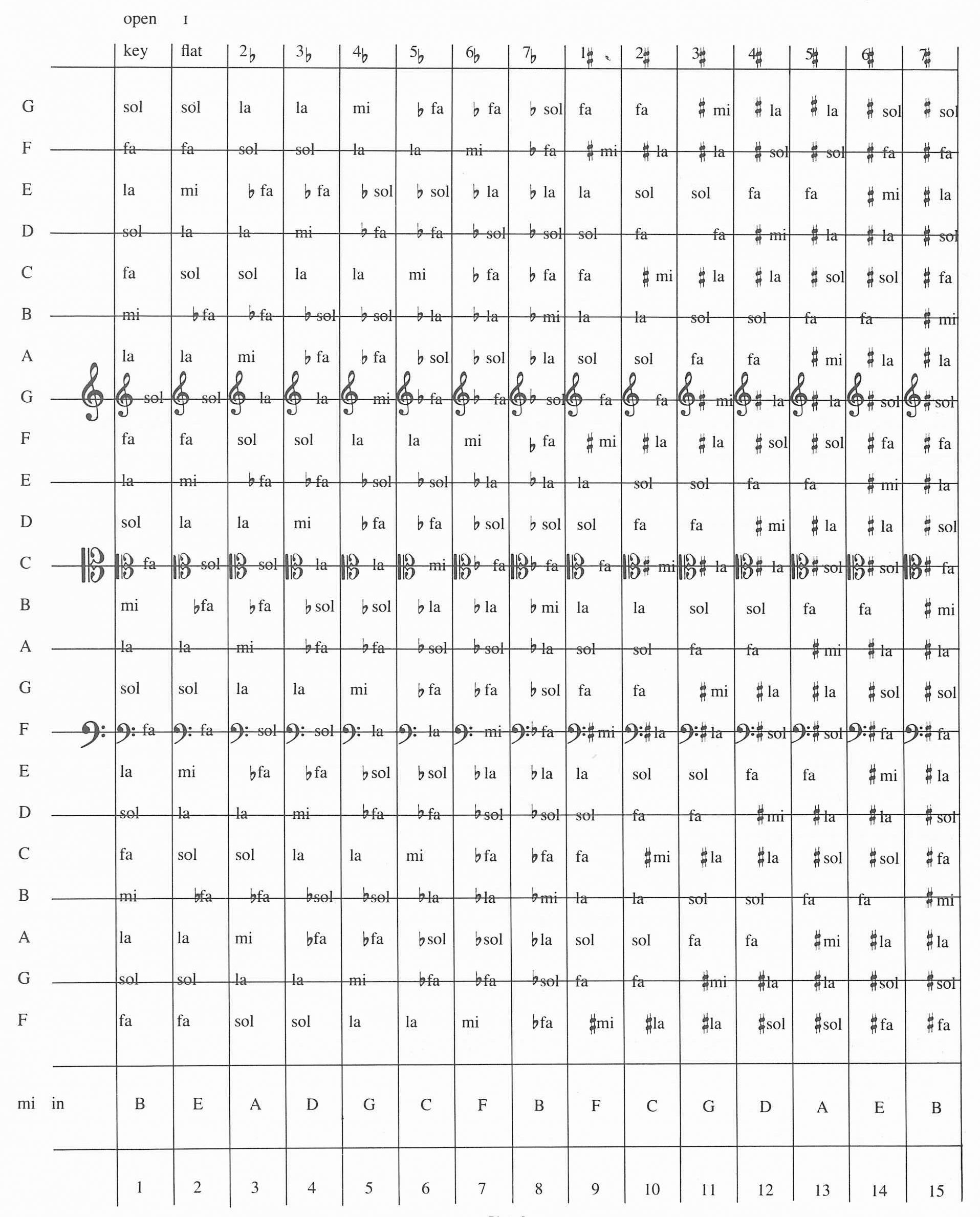
Plate 1
Having explained the Gamut in as clear a Light as I am Master of, I shall proceed to the Explanation of the Three several Cliffs, each in their Order.
First, The F. faut or Bass Cliff, is generally set on the highest Line but one of the Five marked as in [Figure 1],

Fig. 1
it gives its place the Name of F, and when sung must be called Fa, unless it is contradicted by Flats or Sharps at the beginning of a Tune.
Secondly, The C Sol faut Cliff is set on any one of the five Lines, as in [Figure 2],

Fig. 2
and gives its Place the Name of C, and when sung must be called Fa, unless contradicted as beforesaid. This was formerly the Tenor Cliff, though it seems at present almost out of Fashion, the Tenor now being commonly set in the G sol.re.ut or Treble Cliff. But in the following Work, I have made use of the C Cliff for the Counter and placed it upon the middle Line, as in [Figure 3],

Fig. 3
which must be called Fa, unless contradicted as beforementioned. This Cliff is now commonly us’d for the Counter, and in my Opinion, is the best of the Three for that Purpose.
Thirdly, the G.sol.re.ut or Treble Cliff is commonly set on the Second Line from the Bottom, as in [Figure 4],

Fig. 4
and when sung must be called Sol, unless contradicted as abovesaid, and is reckoned to be the best Cliff, either for Tenor or Treble of any now in use.
Here I think it may not be amiss to exhibit an Example of the Gamut divided into the Three several Cliffs, after the Manner they are taught, by the help of which any Person may learn to call their Notes without the Aid of a Master, as in [Figure 5].
CHAP. II.
Containing a Scale of the four Parts, as they are set down according to the Gamut.
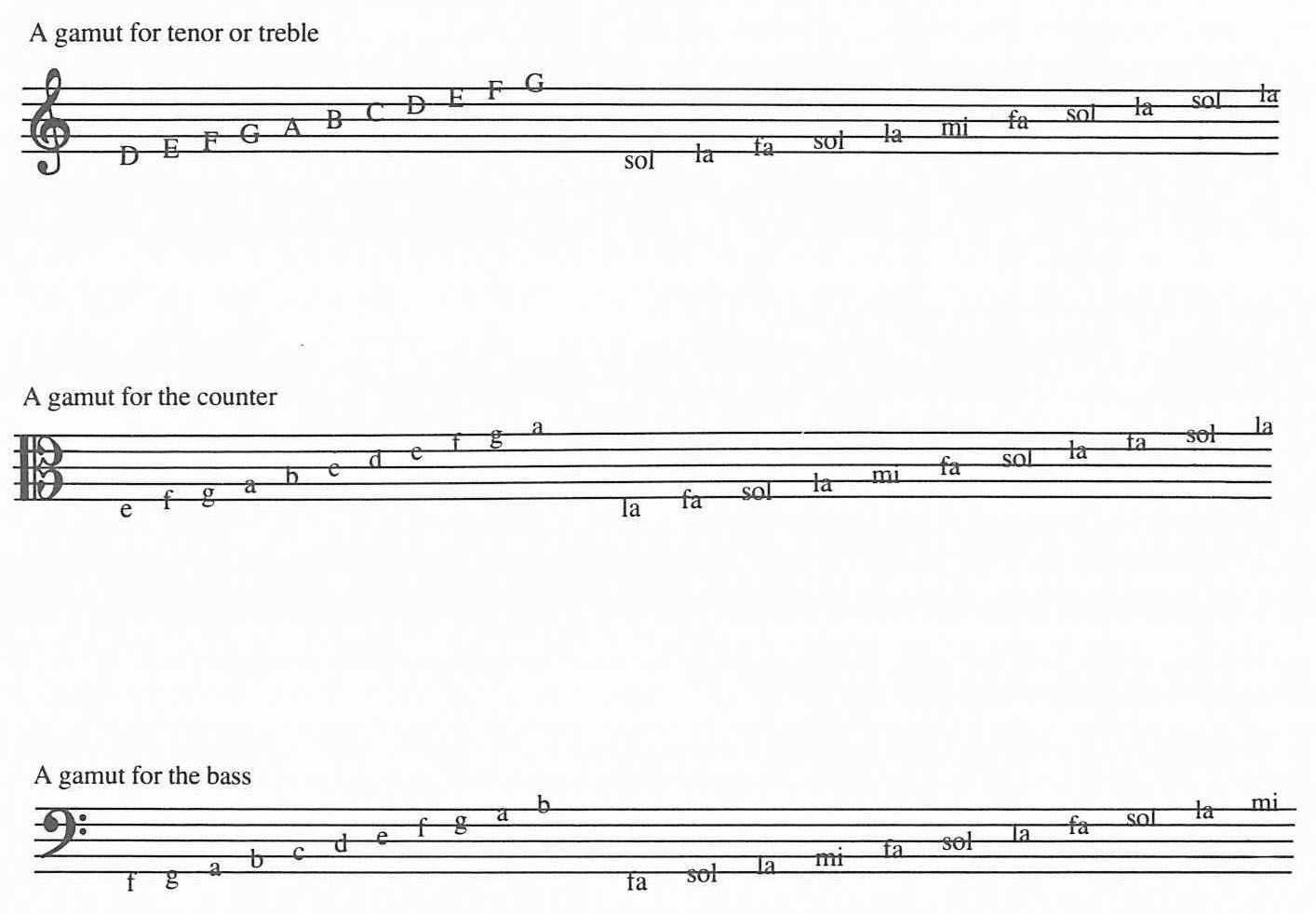
Fig. 5
THIS Scale (see [Figure 6]) plainly proves, the Treble to be naturally an Eighth above the Tenor, although I have often heard it disputed. For some will say, if an Eighth, why not a Fifteenth; nay I have heard some positively affirm that it is a Fifteenth, which is so Inconsistent with Reason, that nothing but Ignorance could inspire the Thought. But if such Persons will but give themselves the Trouble to look into this Example, they will presently find themselves in a gross Mistake. Because from the lowest Space in the Bass, which is upon A, to the highest Space in the Treble, which is upon E, is but a Nineteenth which you may easily see by counting up the Letters between them; whereas according to their Opinion, if you were to raise it the other Eighth, it would be a Twenty Sixth, which is almost out of the Reach of the human Voice. On the other Hand, if you will look into the Parts separated, you will find the Treble ending upon A. and likewise the Tenor. Trace them back into the Scale, and you will find them exactly an Eighth apart, which is a plain Demonstration that a Man cannot sing a proper Treble without counterfeiting a Woman’s Voice, which is very unnatural, and in the Ears of most Judges very Disagreeable: Neither can a Woman sing a proper Tenor without counterfeiting a Man’s Voice, which is also unnatural and disagreeable: But a Man may sing a Treble the Eighth below, and a Woman a Tenor the Eighth above, and then they will act upon Principles of Nature, and may make good Music, for every Eighth or Octave in Effect is the same.
CHAP. III
Containing Rules for tuning the Voice, &c.
OBSERVE, That in raising the Eight Notes, there are two Semi or half Tones, and those are from Mi to Fa, and La to Fa, ascending; and from Fa to La, and Fa to Mi, descending. So that an Octave consists of Five whole Tones, and two half Tones; but for your better Instruction, observe the following Mathematical Scale, calculated to shew all the Semi Tones included in an Eighth or Octave with the Concords and Discords figured on the Lines and Spaces, by Way of Inches and half Inches, in Form of a Pitch Pipe, as in [Figure 7].
Explanation of a Concert Pitch Pipe.
THIS Scale, which is drawn according to the Keys of an Organ, is precisely six inches long, and contains the seven Sounds in Nature, which may be divided into twelve semi or half Tones. N.B. G sharp and a b [a flat] are Unison to each other. B b [b flat] and A sharp, D b [d flat] & C sharp, E b [e flat] & D sharp, G b [g flat] & F sharp, &c. &c. &c. For example, see [Figure 7].
CHAP. IV.
Containing some Characters us’d in Musick, with their Explanations, &c.

Fig. 8
THIS Table comprehends the Six several Sorts of Notes that are now in Use, with their Rests under them, and their Names and Proportions at Top, which I shall explain in their Order, and begin with
1st. The Semibreve which is the longest Note now in Use, though formerly the shortest, whose Length and Proportion of Time, is as long as you may leisurely tell 1.2.3.4. your best Guide in this Case will be the Pendulum of a large Chamber Clock, four Vibrations of which being exactly the Time of one Semibreve: This is the Measure Note, and guideth all the Rest.
2d. The Minim, is but half the Length of the Semibreve, having a Tail to it.
3d. The Crotchet is but half the Length of a Minim, with a black Head and Tail.
4th. The Quaver is but half the Length of a Crotchet, with a Tail turn’d up.
5th. The Semiquaver is but half the Length of a Quaver, with two Tails turn’d up.
6th. The Demisemiquaver is but half the Length of a Semiquaver with three Tails turn’d up; this is the shortest Note now in Use.
N.B. Rests are notes of Silence, which signify that you must rest or keep Silence as long as you would be sounding one of the respective Notes to which they belong, as in [Figure 8].
There is another Character used in Music, call’d a Prick of Perfection or Point of Addition, mark’d thus (.) when this Point is set to a Semibreve, it must be held as long as three Minims, because it makes the Note half as long again as it was before. Here it may not be amiss to give you an Example of prick’d Notes, as in [Plate III].
CHAP. V.
Containing an Explanation of several Musical Characters.
First, a Flat is a Mark of Contraction, and serveth to sink any Note half a Tone lower than it was before. Flats [are] also us’d to regulate the Mi in the Transposition of Keys.
2d. A Sharp is a Mark of Extension, it being to raise a Note half a Tone higher than it was before. Sharps are also us’d to regulate the Mi in the Transposition of Keys.
3d. A Repeat is us’d to direct the Performer that such a Part or Strain must be repeated over again, from the Note that it is set over or under. This Character is also us’d in Canons to direct the following Parts to fall in, at such Notes as it is plac’d over.
4th. A Slur is in Form like a Bow drawn over or under the Heads of two, three or more Notes, when they are to be Sung but to one Syllable.
5th. A single Bar serves to divide the Time in Music according to the Measure Note.
6th. A Double Bar serves to divide many Strains in Music. But if they be Dotted on each Side, thus 𝄈𝄁𝄈 it signifies that such a Strain must be repeated over again. Double Bars are us’d in Psalm Tunes, to divide the Tune into Metre, and likewise to stop to take Breath if you please.
7th. A Direct is plac’d at the End of a Line to direct the Performer to the Place of the first Note in the next Line.
8th. A Natural is a Mark of Restoration, which being set before a Note, that was made Flat or Sharp at the Beginning, restores it to its former Natural Tone.
9th. A Shake or Trill, is to direct the Performer to Shake or Grace any Note it is plac’d over.
10th. A Close is three, four, or more Bars together, and always set after the last Note of a Piece of Musick, which signifies a Conclusion, or the Closing of all Parts in a proper Key, as in [Figure 9].
There is yet another Character call’d a Divider, commonly mark’d as in [Figure 9], which Divides the Score of the Composition, shewing what Parts move together, and what do not.

Fig. 9
CHAP. VI.
Of Time in its various Moods, and how to Beat it in each of them.
THIS Part of Musick called Time, is so necessary to be understood, that no Person can ever be able, without it, to Sing as he ought to do; neither can his Musick yield any Delight to himself or others; for, if there be not an exact Agreement of Time in all the Parts, it causes the Musick to Jarr and Disagree; but, if rightly understood by all the Performers, it causes the Parts to move and agree one with another, according to the Design of the Composer.
There are several Sorts of Moods for Time, yet all are deduced from two, viz. Common Time and Tripla Time, which are measured by either an even or odd Number of Notes, as 4 or 3; not precisely so many Notes in Number, but the Quantity of such like Notes, to be included in every Bar.
But next I shall give you an Example of the several Moods commonly us’d in Psalmody, as in [Figure 10].

Fig. 10
Explanation of the several Moods.
THE First of these Moods is called Adagio which is a very slow Movement. A Semibreve in this Mood is precisely the Time of four Seconds. You may Beat it two several Ways, either with your Hand once down, and once up in every Bar, which is called Minim Beating, or twice down and twice up which is called Crotchet Beating. Where the Tune chiefly consists of Minims, I would recommend the first, but where the Musick consists of lesser Notes, I would recommend the latter to be the easiest and plainest Way, because every Crotchet is exactly one Second, which is a very natural and easy Motion.
The second Mood or Mark is called the Largo Mood being half as quick again as the former, so that three Minims in this Mood are to be perform’d in the same Time that two Minims are in the Adagio Mood, but it is often fix’d to Psalm Tunes, in which the Crotchets and all other Notes in Proportion are Sung in the Time of Seconds, so as to make no Distinction between this and the Adagio Mood except in the Anthems and other brisk Pieces of Music.
The third Mood or Mark is called the Allegro Mood, being as quick again as the first, so that Minims in this Mood are Sung to the Time of Seconds. N.B. This is a very beautiful Movement, and if rightly perform’d carries great Life and Spirit with it.
There is another Mood sometimes used in Psalmody, mark’d as in [Figure 10], and is called two from four, each Bar containing two Crotchets, one to be beaten down, and the other up. And Crotchets in this Time must be quick as Crotchets in the Allegro Mood. Thus much for Common Time.
Explanation of the several Moods of Tripla Time
TRIPLA Time is measur’d by odd Numbers, as 3, 6, 9, &c. each Bar including either three Semibreves, three Minims, three Crotchets, or three Quavers, two of which must be sung or play’d with the Hand down, and one up, so that you are just as long again down as up. The first and Slowest Mood is called three to two, each Bar including three Minims, or one pointed Semibreve which are perform’d in the same Time as three Crotchets in Adagio. Two Beats down, and one up, mark’d thus 32.
The second Sort of Tripla Time is called Three from Four: Each Bar including three Crotchets, or one pointed Minim. A Crotchet in this Mood to be performed in the same Time as a Crotchet in Largo, two Beats down, and one up mark’d thus 34.
The third Sort of Tripla Time is called Three from Eight, each Bar including three Quavers or one pointed Crotchet, two beats down and one up, each Bar being performed as quick again as Three from Four, mark’d thus 38.
Thus much for Tripla Time.
In keeping Time the Hand may be a Guide,
Yet Thought’s the Prime in which you must confide.
The most correct Way is to beat Time by Pendulums.2
Of the Grace of Transition.
THIS Grace, called the Grace of Transition, if rightly performed, is one of the greatest Ornaments to Music that can be used; and in my Opinion, the turning of Thirds up and down, is one of the nicest Points, and if well done, beautifies the Musick exceedingly, whether Vocal or Instrumental.

Fig. 11
N.B. When you see three Notes of any Kind with a Figure of 3, they are to be sung in the Time of one Beat; that is, if the Time be 32, they are to be sounded the Length of a Minim; but if the Time be 34, they are to be sung in the Time of a Crotchet, &c.
Note also—That when you meet with two Notes standing one over the other, they are called choosing Notes, and signify that you may sing which you please, or both if you have Voices enough, and remember that they add not to the Time, but to the Variety.
CHAP. VII.
Of the several Keys in Musick, and how to Transpose any Tune out of either of the two natural Keys, by Flats, or Sharps into any other Key.
THERE are but two natural primitive Keys in Musick, viz. C, the sharp and cheerful Key, and A, the flat and melancholly [sic] Key. No Tune can be formed rightly and truly, but in one of these two Keys, except the Mi be transposed by either Flats or Sharps, which are set at the Beginning of the five Lines, which brings them to the same Effect as the two natural Keys.
These two Keys must be rightly understood, before any great Proficiency can be made in Musick; they are very nice Points, and are worth the Learners [sic] While to strive for the Attainment of. It is a Proof of a very nice Taste and Discernment in a Chorister, to chuse a Flat Key Tune for a Psalm of Penitence and Prayer; and likewise a sharp Key Tune for a Psalm of Praise and Thanksgiving. But to sing a Psalm of Praise in a flat Key Tune, and a Psalm of Prayer in a sharp Key Tune, would be a direct Contradiction. The Musick and the Words would greatly tend to lessen the Beauty of each other. But you must endeavor to make the Musick conform to the Words; then they will serve to beautify each other. But next I shall proceed to give an Example of the several Keys, both Natural and Artificial. For example see [Figure 12 and Plate IV].
Thus I have given an Example of the several Keys, both natural and artificial, into which B. Mi is transpos’d; and I would have it be remembered that it is not Flats that make flat Keys, nor Sharps that make sharp Keys. But it is B. Mi which is always next to the Key Note, either above or below; if below, then it is a sharp Key, and if above, then it is a flat Key.
Observe, That the last Note in the Bass is the Key Note, and contains the Air of the whole Tune: For a Tune depends as much on its proper Key, as a Sermon does on its Text. Thus much for Keys.
CHAP. VIII.
Of the Doctrine of Concords and Discords, both Perfect and Imperfect.
THERE are but four Concords, in Music, viz. the Unison, Third, Fifth and Sixth, their Eighths or Octaves are also meant. The Unison is call’d a perfect Chord, the Fifth is also call’d a Perfect Chord, the Third and Sixth are call’d Imperfect, their Sounds being not so full and Sweet as the Perfect.
The Discords are a Second, Fourth and Seventh, and their Octaves. Here take an Example of Concords and Discords with their Octaves under them.
N.B. If a Voice or Instrument, could reach to Ten Thousand Octaves,3 they all counted as one in Nature.
CHAP. IX.
Thoughts on MUSIC
IN Order to make good Music, there is great Judgment required in dividing the Parts properly, so that one shall not over-power the other. In most Singing Companies I ever heard, the greatest Failure was in the Bass, for let the Three upper Parts be Sung by the Best Voices upon Earth, and after the Best Manner, yet without a sufficient Quantity of Bass, they are no better than a Scream, because the Bass is the Foundation, and if it be well laid, you may build upon it at Pleasure. Therefore in order to have good Music, there must be Three Bass to one of the upper Parts. So that for Instance, suppose a Company of Forty People, Twenty of them should sing the Bass, the other Twenty should be divided according to the Discretion of the Company into the upper Parts, six or seven of the deepest Voices should sing the Ground Bass, which I have set to most of the Tunes in the following Work, and have taken Care to set it chiefly in the compass of the Human Voice, which if well sung together with the upper Parts, is most Majestic, and so exceeding Grand as to cause the Floor to tremble,4 as I myself have often experienced. Great Care should also be taken to Pitch a Tune on or near the Letter it is set, though sometimes it will bear to be set a little above and sometimes a little below the Key, according to the Discretion of the Performer; but I would recommend a Pitch Pipe, which will give the Sound even to the nicety of a half a Tone.
Much caution should be used in singing a Solo, in my Opinion Two or Three at most are enough to sing it well, it should be sung as Soft as an Eccho [sic], in order to keep the Hearers in an agreeable Suspense till all the Parts join together in a full Chorus, as smart and strong as possible. Let all Parts close in a proper Key, and a full Organ, which will yield great delight5 both to the Performers and Hearers.
Thus gentle reader you have my Sentiments upon the Matter.
|
No Doubt they’re Faulty, pray excuse ’em. If you like ’em, prithee use ’em, Criticks, be Tender, don’t abuse ’em. |
|
Your’s,
W.B.
On MUSICK.
HAIL sacred Music, which of all the Sweets
From Heaven deriv’d for Man to taste, art chief.
In all the various Frames of Man, ’tis thine
To move the Various Passions of the Soul.
When Pain usurps the Empire of the Breast,
Thy soothing Balsam can assuage the Sting,
And pour the Balm of Pleasure on the Wound.
When Grief and Cares hang heavy o’er the Mind,
And gloomy Melancholy clogs the Thought,
Thy enliv’ning Beams can dissipate the Cloud,
And warm the Soul with rapturous Delight.
When Passion rages over all the Man,
’Tis thine to calm the Tempest of the Mind,
And soften all the Hero into Love.
Again ’tis thine to call the Lover forth,
From the soft Scenes of Pleasure and Amour,
To brave the Dangers of the bloody War.
The Savage owns thy almost magic Power,
To Tame the Native Wildness of his Breast,
And melt the icy Fibres of his Heart.
Again the Lion raging for his Prey,
When Musick meets him on his rapid Course,
Struck into Pause, let’s [sic] drop his Fury there,
In fond Attention to the pleasing Charm.
Such is the Nature of the vital Clay,
Such the Formation of its curious Parts,
That all the nicer Passions of the Man,
And every coarser Instinct of the Brute,
Are sweetly subject to the Powers of Sound.
Philo-Musico.
Cambridge, Sept. 30, 1770.
To all Musical Practitioners.
PERHAPS it may be expected by some, that I should say something concerning Rules for Composition; to these I answer that Nature is the best Dictator, for all the hard dry studied Rules that ever was prescribed, will not enable any Person to form an Air any more than the bare Knowledge of the four and twenty Letters, and strict Grammatical Rules will qualify a Scholar for composing a Piece of Poetry, or properly adjusting a Tragedy, without a Genius. It must be Nature, Nature must lay the Foundation, Nature must inspire the Thought. But perhaps some may think I mean and intend to throw Art intirely [sic] out of the Question, I answer by no Means, for the more Art is display’d, the more Nature is decorated. And in some sorts of Composition, there is dry Study requir’d, and Art very requisite. For instance, in a Fuge, where the Parts come in after each other, with the same Notes; but even there, Art is subservient to Genius, for Fancy goes first, and strikes out the Work roughly, and Art comes after, and polishes it over. But to return to my Text; I have read several Author’s [sic] Rules on Composition, and find the strictest of them make some Exceptions, as thus, they say that two Eights or two Fifths may not be taken together rising or falling, unless one be Major and the other Minor; but rather than spoil the Air, they will allow that Breach to be made, and this allowance gives great Latitude to young Composers, for they may always make that Plea, and say, if I am not allow’d to transgress the Rules of Composition, I shall certainly spoil the Air, and Cross the Strain, that fancy dictated: And indeed this is without dispute, a very just Plea, for I am sure I have often and sensibly felt the disagreeable and slavish Effects of such a restraint as is here pointed out, and so I believe has every Composer of Poetry, as well as Musick, for I presume there are as strict Rules for Poetry, as for Musick. But as I have often heard of a Poetical Licence, I don’t see why with the same Priority there may not be a Musical Licence, for Poetry and Music are in close Connection, and nearly allied, besides they are often assistants to each other; and like true friends often hide each others [sic] failings: For I have known a Piece of Poetry that had neither “Rhime nor Reason”6 in it, pass for tolerable good Sense, because it happened to be set to an excellent Piece of Musick, and so get respect rather for its good fortune in falling into such respectable Company than for any Merit in itself; so likewise I have known and heard a very indifferent Tune often sung, and much caress’d, only because it was set to a fine Piece of Poetry, without which recommendation, perhaps it would not be sung twice over by one Person, and would be deem’d to be dearly bo’t only at the expence [sic] of Breath requisite to perform it—for my own Part, as I don’t think myself confin’d to any Rules for Composition laid down by any that went before me, neither should I think (were I to pretend to lay down Rules) that any who came after me were any ways obligated to adhere to them, any further than they should think proper: So in fact, I think it is best for every Composer to be his own Carver. Therefore, upon this Consideration, for me to dictate, or pretend to prescribe Rules of this Nature for others, would not only be very unnecessary, but also a great Piece of Vanity.
CHAP. X.
Containing an Explanation of the most Useful Terms that are us’d in Musick; particularly of those that are in this Book, set down in Alphabetical Order.
Adagio—very slow or the slowest Movement of Time.
Allegro—a very quick Movement, being as quick again as Adagio.
Affetuoso—very Tender and Affectionate.
Allelujah—PRAISE THE LORD.
Altus—The Counter.
Breve—a Note containing two Semibreves.
Bass—The lowest foundational Part & generally confin’d to the F Cliff.
Binary—up, and down, both equal.
Cliff—the Key to open a Piece of Musick.
Cadence—All Parts making a Close.
Canon—A perpetual Fuge.
Chant—to sing, also the Church Tune.
Chorus—all Parts moving together.
Close—all Parts ending in Harmony.
Counter-Tenor—between Treble and Tenor may be set in the C or G Cliff.
Da-Capo—End with the first Strain.
Demi—The Half.
Diapason—a perfect Eighth.
Disdiapason—a Fifteenth.
Divoto—in a devout Manner.
Dux—the leading Fuge or Part.
Doubles—all Notes that descend below Gamut, viz. the lower line in the Bass, are called Doubles; as double F, double E, double D, double C, double B, double A, double G; and all below double G, are called double double; as double double F, &c.
Eccho—soft like an Eccho.
Encore—over again more yet, the same as Repeat.
Forte—Loud, Strong.
F, faut—in the Bass one whole Tone below G solreut in the Tenor
Fortissimo—very loud.
Fin—The last or finishing Note.
Fuge or Fuging—Notes flying after of the same. N.B. Fuging is accounted the most ingenious and generally the most grateful both to Performers and Auditors, of any Part in Composition.
Granda—very grand or the greatest.
Gratioso—graceful and agreeable.
Guida—the leading Voice or Instrument.
Gravasonus—very grave and solid.
Harmonick Sounds—Sounds agreeable.
Hemi—The Half.
Hallelujah—Praise ye the Lord.
In harmonical—sounds disagreeable.
Ledger Lines, viz.—Lines that run above or below the five Lines.
Lamantatone—Lamenting and Grave.
Large—a Note containing two Longs.
Long—a Note containing two Breves.
Languissiant—in a languishing Manner.
Largo—a Middle Movement of Time, being half way between Adagio and Allegro.
Musico-Theorico—a Composer, a Master or Teacher of Musick.
Medius—The Counter Part or Treble, sung an Octave below itself with a Tenor Voice.
Major—The Greater.
Maestuso—With Majesty and Grandeur.
Minor—The Lesser.
Moderatio—Of a moderate strength.
Nota-Bene—Mark well.
Octave—A perfect Eighth of 12 Semitones.
Oscillation—A vibrating or swinging.
Organo—The Organ Part.
Organ—The grandest of all Wind Instruments.
Piano—soft and sweet like an Eccho.
Presto—Quick.
Pieno—Full, or altogether.
Philo-Musico—A lover of Musick.
Quarta—Four Parts in Score.
Rectre & Rectro—Forwards & Backwards.
Replica—Let it be repeated.
Semi—the Half.
Score—All Parts standing Bar against Bar, according to the strictest Rules. N.B. Musick out of score, said to be like Tune without Time.
Semitonick—The Octave divided into 12 Sounds.
Solo or Solus—Either Part alone.
Syncopation—Sounds driven thro’ the Bars.
Treble—The 3d Octave above the Bass, adapted to Feminine Voices in either Sex, cannot with Propriety be set in any other but the G Cliff. Observe that G solreut in the Treble is an Octave above G solreut in the Tenor Mathematically prov’d in [Figure 6].
Tacet—Silence.
Tenderment—In a tender Manner.
Transposition—Removing from one Key to another.
Tre or Trio—Three Parts.
Tritone—A greater 3d of 4 Semitones.
Tripla—Time moving or measured by Threes.
Tenor—The second Octave above the Bass, also the leading or Church Part, and may be set in the C or G Cliff, if in the latter it must be sung an Eighth below the Treble, see [Figure 6].
Tutt or Tute—All Voices together.
Unison—One and the same Sound.
Vivace—Gay, quick and lively.
Veloce—Very quick.
Vivacissimo—With Life and Spirit.
Vibration—Shaking or Trembling.
Vigoroso—With Life and Vigour.
Voce-Solo—A Solo to be performed by a single Voice.
N.B. These are the most general Terms us’d in Musick, therefore most beneficial for Learners.
P.S. Musick Pens for drawing the 5 lines at once, made & sold by Josiah Flagg, at his Shop in Fish-Street, at the North-End of Boston.
(Price 50s. Old Tenor.)
ADVERTISEMENT.
To the generous Subscribers for this Book.
THE Author having to his great Loss deferred the Publication of these Sheets for Eighteen Months, to have them put upon American Paper, hopes the Delay will be pardoned; and the good Ladies, Heads of the Families, into whose Hands they may fall, will zealously endeavour to furnish the Paper Mills with all the Fragments of Linnen [sic] they can possibly afford: Paper being the Vehicle of Literature, and Literature the Spring and Security of human Happiness.
The Reader is desired to excuse my inserting the following Explanatory Piece so much out of Place, but the Reason is because it intirely [sic] slipt my Memory till the Introduction was Printed—it being very essential to be understood, I could not (in Justice to the Learner) omit it.
You will often meet with the Figures 1, 2. The Figure 1 standing over one Bar, and 2 over the next Bar, with a Repeat7 standing between them; it signifies that [the] Strain from the Figure 1, [is] to be repeated; that is, you must look back from Figure 1, till you find a Repeat, and observe that in going over that Strain the second Time, you omit the Bar under Figure 1, and perform the Bar under Figure 2.—And you will find upon Examination, that it is so contriv’d, to make out full Bars, as for Example—suppose the Time be 32 and the Bar under Figure 1 contains but a Semibreve, then by borrowing a Minim out of the first Bar that is repeated, you fill the Bar under Figure 1; and you must take it for granted that the Bar under Figure 2, is, or ought to be full, without borrowing; so that by omitting the Bar under Figure 1, in repeating, you have all Bars full.—For an Example of this Nature, I would refer you to Pumpily Tune. And oftentimes in plain Psalmody, where the Time is 32, you will find but one Minim in the first Bar, and a Semibreve in the last Bar: And in this Case, they both make one Bar; so that by borrowing of each other, they may both be full, that is, if I beat two Beats down on the Semibreve, then in Singing the Tune the Second Time, I sing the Minim with my Hand up, it compleats the Bar; and when you have sung the Tune as often as you propose, you must leave off with the Two Beats down, without raising your Hand, because unless you begin the Tune again, the Bar is Imperfect.
N.B. This Example holds good in 34 and 38.
An HYMN compos’d by the Rev. Mr. WHITEFIELD, [recte Charles Wesley (see Julian, p. 32)] with design to be sung at his own Funeral, And here inserted at the Request of a Number of his Friends.
Adapted to Marshfield Tune, p. 276, Brookfield ditto, p. 64, or Westfield ditto, p. 254.
I.
AH! lovely Appearance of Death!
No Sight upon Earth is so fair;
Not all the gay Pageants that breathe,
Can with a dead Body compare.
II.
With solemn delight I survey,
The Corpse when the Spirit is fled;
In love with the beautiful Clay,
And longing to lie in it’s [sic] Stead.
How blest is our Brother, bereft
Of all that could burthen his Mind!
How easy the Soul that hath left
This wearisome Body behind!
IV.
Of Evil incapable thou,
Whose Relicts with Envy I see;
No longer in Misery now,
No longer a Sinner like me.
V.
This Earth is affected no more
With Sickness or shaken with Pain;
The War in the Members is o’er,
And never shall vex him again.
VI.
No Anger hence forward, or Shame,
Shall redden this innocent Clay.
Extinct is the Animal Flame,
And Passion is vanish’d away.
VII.
This languishing Head is at rest,
Its thinking and aching are o’er;
This quiet immoveable Breast
Is heav’d by Affliction no more.
VIII.
This Heart no longer the Seat
Of Trouble and torturing Pain,
It ceases to flutter and beat,
It never shall flutter again.
IX.
The Lids he so seldom could close,
By Sorrows forbidden to sleep,
Seal’d up in eternal Repose,
Have strangely forgotten to weep.
X.
The Fountains can yield no Supplies,
These Hollows from Water are free,
The Tears are all wip’d from these Eyes,
And evil they never shall see.
XI.
To mourn and to suffer is mine,
While bound in a Prison I breathe,
And still for Deliverance pine.
And press to the Issues of Death.
XII.
What now with my Tears I bedew,
O! Might I this Moment become!
My Spirit created anew,
My Flesh be consign’d to the Tomb

